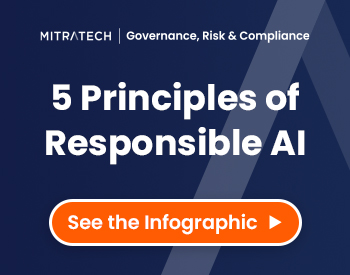Proactively governing AI doesn’t need to keep you up at night, but you should start now.
The EU AI Act certainly sparked a flurry of regulatory interest, but it wasn’t the first milestone we’ve seen in AI Governance. The U.S.’s First AI Executive Order was released last October, for example. And before that, you could trace an entire timeline of the evolution of AI governance in GRC (which we actually did).
Then there’s the innovation side of the equation; ChatGPT’s model is not only improving rapidly, but now has serious competitors. While about 42% of enterprise-scale companies report having actively deployed AI in their business, 40% more are currently exploring or experimenting with AI. Hesitations to roll out AI in an organization are often born from anxiety around expertise gaps, data complexity, and ethical concerns.
In order to explore AI in a safe way, companies must begin to govern their AI – or pay the price. And there is no company untouched by the new technology. Every company, whether directly integrating AI into its tech stack or not, is at risk of AI misuse. Employees might unknowingly use AI tools without proper oversight or understanding. These problems call risk and compliance leaders to begin governing AI. Let’s dive into the first 6 steps you should take.
6 Steps to Better AI Governance
There are six key steps you can take to improve your organization’s AI governance today:
- Know where your AI lives
- Investigate the AI risks
- Educate your company on AI
- Understand how much risk your company is willing to take on
- Define a cadence for inventory review
- Begin to operationalize your AI governance plans
Take a closer look at each below.

1. Know where your AI lives
Do you even know where your AI systems are within your organization? What about the AI that your third-parties use? Conduct a comprehensive audit to identify all AI tools and platforms. If you’re uncertain about the complete inventory, consider a hybrid approach of attestation and a digital sweep.
2. Investigate the AI risks
Understand the potential risks associated with your AI systems. For instance, does your AI introduce bias? What would be the ramifications if these systems were manipulated or exploited? Evaluate the significance and reach of these risks, which will help in prioritizing mitigation strategies.
- Bias Introduction: How does your AI model handle diverse data inputs
- Data Security: What measures are in place to protect against data breaches?
- Compliance: Are your AI systems compliant with relevant regulations?
- Operational Impact: How would AI failures affect business operations?
- Reputation Risk: Could AI errors damage your brand reputation?
- Financial Risk: What are the potential financial losses from AI failures?
3. Educate your company on AI
The very novelty of AI makes it difficult for employees and employers to manage. In order to mitigate bias and prevent serious mistakes, take the time to engage your colleagues (and your company!) and educate them on the risks associated with AI.
This knowledge lays the foundation for an ethical AI governance model by helping employees identify when AI might give biased, false, or misleading information. The steep learning curve for AI literacy calls for training employees now, helping them understand the risks as technology advances and changes.
4. Understand how much risk your company is willing to take on
Engage stakeholders in continuous discussions about their risk appetite. This allows them to provide more detailed insights into acceptable risk levels once the risks are identified.
5. Define a cadence for inventory review
Establish a regular schedule for updating your AI inventory. The frequency should be based on the risk level of each AI system. High-risk AI may require a review every three months, while lower-risk systems could be reviewed annually.
6. Begin to operationalize your AI governance plans
Encourage collaboration among stakeholders (including experts, policymakers, and the public) and foster an inclusive approach to decision-making and policy development. More transparency will have the side effect of educating your stakeholders and elevating your company’s AI literacy.

Build Trust With AI Governance
By proactively governing AI, companies can mitigate risks, ensure compliance, and foster trust in AI technologies. The wide range of regulations – and the use cases that they prepare for – prove that it is unclear exactly how AI will put companies and publics at risk. It is clear, however, that AI will continue to be regulated at a granular level across the globe, and that companies can no longer wait to implement an AI governance model. Some software solutions govern the entire AI life cycle within one platform, enabling organizations to maximize the benefits of a comprehensive AI governance program.
Our focus? On your success.
Schedule a demo, or learn more about Mitratech’s products, services, and commitment.





